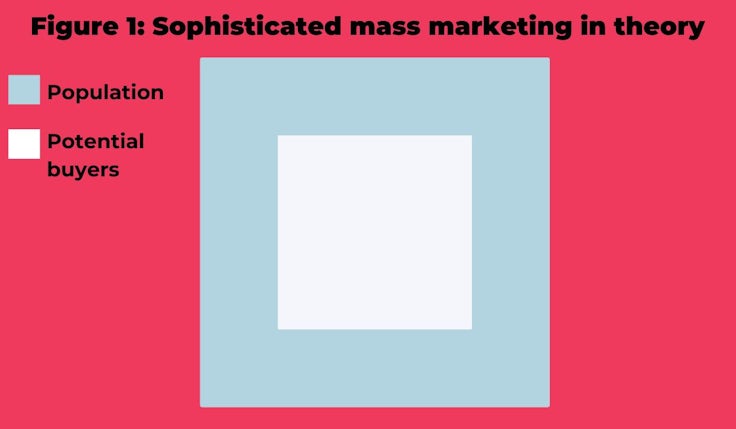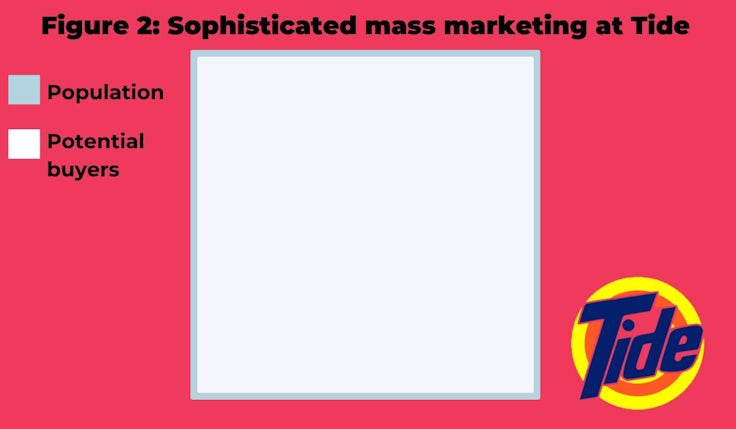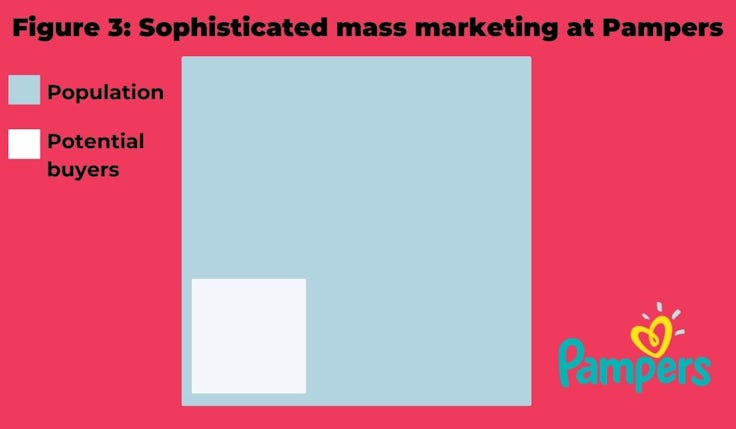
Even sophisticated mass marketers need targeting
After a short sabbatical to launch this year’s Mini MBA, our trusty marketing columnist returns to talk targeting, and why this ancient topic is one of the biggest challenges most marketers now face. Not despite the industry’s new-found love for mass marketing, but because of it.
“How many of you brush your teeth daily?” Marc Pritchard, P&G’s chief brand officer, recently asked a room full of marketers. “Who uses toilet paper?” was his outstanding follow up. I am relieved to report that every available hand in the room went into the air.
“There’s no reason to settle for media reach of 50% to 70%,” Pritchard went on to explain. With so many of the categories that P&G operates in proving relevant to 100% of the population, settling for reach in the 50th or even 70th percentile makes no sense. His company is now setting the targeting bar much higher, at 90% to 100% of American households, because patently all of them could and should be potential consumers.
He used the example of Tide detergent, which now reaches 86% of the US population according to the latest audience data. But Pritchard isn’t happy, even with that proportion. He is bringing media in-house, focusing on connected TV, prioritising reach over frequency in a concerted attempt to target 100% of American households for his detergent brand.
 You could not invent a more impressive argument for sophisticated mass marketing – the concept espoused by the Ehrenberg-Bass Institute a decade ago as a gigantic rejoinder to an industry obsessed with partitioning the market into (often arbitrary) segments and then inexplicably targeting only a tiny portion of the potential market.
You could not invent a more impressive argument for sophisticated mass marketing – the concept espoused by the Ehrenberg-Bass Institute a decade ago as a gigantic rejoinder to an industry obsessed with partitioning the market into (often arbitrary) segments and then inexplicably targeting only a tiny portion of the potential market.
Just because you subscribe to mass marketing does not eliminate the need for targeting capabilities – quite the reverse.
Sophisticated mass marketing changed all of that while still making it clear that this did not simply mean targeting everyone with a pulse. The prefix ‘sophisticated’ meant that marketers had to first identify the total potential market and make that their target, not simply the whole population.
As Pritchard’s impolite questioning revealed, there are a lot of categories that are unsophisticated in their construction. In other words, the total population and the potential market are pretty much one and the same. Products like toilet paper, detergent, banking and mobile phone networks are essentially relevant to everyone. Sure, there are some people who don’t bank or wash their clothes. But the effort to weed these outliers from the population is rendered ridiculous by their tiny proportions. It is simply not worth it. To all intents and purposes, these brands – like Tide – might as well target everyone in the population and aim for 100% reach.
 How do you define the whole market?
How do you define the whole market?
But it’s not always this simple. Even when a brand signs up to a sophisticated mass marketing approach, it almost immediately encounters a complex question just as tricky as anything an earlier segmentation model would have thrown them. Because sophistication requires a definition of who is, and who isn’t, in the market for a product.
In some cases that’s as simple as Tide concluding that everyone washes their clothes. But most of the time there is a lot of grey ground to cover between a brand’s existing customer base, the outer ring of potential buyers, and the final perimeter fence of the total population. Just as marketers once spent weeks slicing up their market, they must now devote just as much time stitching it all together.
If I am marketing mortgages, for example, is the total market everyone currently with a home loan? Everyone looking for a home loan? Everyone who owns a home? Everyone that wants to own a home? Everyone that will one day want to own a home? And should everyone that says they want to one day own a home be believed, given many will never be able to afford one?
You see my point? Signing up for sophisticated mass marketing does not shut down the complexity of target marketing. It just changes the colour of that complexity.
Prichard, for example, illustrated the point with another of the big brands in the P&G stable. Pampers, the leading nappy brand in America, also subscribes to the sophisticated mass marketing credo. But not everyone needs nappies. Pritchard uses the extraordinarily arousing concept of “diapering households” to define who is and isn’t in the market for Pampers. At any one time 10% of American households are the diapering kind.
I’ve lived in a “diapering household”, eventually escaping, alive, to tell the tale. Now, thanks to the efforts of Mrs Ritson and the miracles of modern fertility, I will soon return there once again. And I tremble at the thought, dear reader. Tremble.
 Anyway, even with Pritchard’s best efforts at mass marketing, Pampers largely failed its targeting task. The brand reached 70% of American parents, but only 5% of households in the diapering phase. There are two ways to get upset about this data. First, the brand’s reach was only a fraction of the sophisticated mass market. Second, there was – ahem – a shit ton of waste expended on parents who weren’t diapering. P&G and its in-house teams are now busy with first-party data and a more advanced approach to improve their reach to diapering households.
Anyway, even with Pritchard’s best efforts at mass marketing, Pampers largely failed its targeting task. The brand reached 70% of American parents, but only 5% of households in the diapering phase. There are two ways to get upset about this data. First, the brand’s reach was only a fraction of the sophisticated mass market. Second, there was – ahem – a shit ton of waste expended on parents who weren’t diapering. P&G and its in-house teams are now busy with first-party data and a more advanced approach to improve their reach to diapering households.
I’ll throw in another complication. Over the past few years, I have worked with a number of large clients who have opted for a sophisticated mass marketing approach – especially at the brand level, where the evidence is that aiming at the whole market does indeed produce the best results. But, despite this strategic commitment, they have come up short tactically when estimating the cost of actually targeting everyone in the market.
Alternatives for the cash-strapped
Sure, Pritchard, P&G and his £6bn ad budget can target everyone that wipes their arse. But, for most companies, the tricky issue of budget constraints cannot be ignored. I have had a number of experiences with clients who philosophically align with mass marketing, only for their advertising budget to vehemently disagree.
In these cases, marketing managers segment their markets not because they reject mass marketing but because they simply cannot afford to do it. Some slice the market geographically, enabling them to mass-market, albeit within a much smaller market area.
I’d love to target American marketers for my Mini MBA courses, for example, but my team are expressly forbidden from spending a dollar on the USA. America is a big country. Acquisition costs for courses are literally 10 times that of every other country we serve, because education is private, established and hugely competitive over there. And I’m a virtual unknown without any organic media to help catalyse the spend. So, while we welcome any and all American marketers – sign up in the link below – we don’t target them. Not because I oppose the idea of mass marketing the Mini MBA, or because I don’t love American marketers, but because I cannot afford to execute the strategy.
Another option for cash-strapped mass marketers is to cut the category into sub-categories. When Jack Taylor left the US navy to start Enterprise Rent-A-Car in 1957, he had dreams of making it the biggest rental player in the world, aimed at every customer who needed a rental car.
But he only had seven cars and a very limited budget, so, in contrast with the competition, he avoided airports and focused on the ‘home city’ sub-category: rental cars required by people whose own vehicle was either being fixed or had been stolen. Today, of course, Enterprise is the biggest car rental company on the planet. It can afford to mass-market. But the reason it can do that is because it didn’t, for a very long time.
Finally, and in the ultimate paradox of sophisticated mass marketing, there are the brands that target segments of customer types – not because they believe in segmentation, but because they believe in mass marketing but cannot afford to reach the whole market. When it started in 1997, most people know that Netflix was a DVD rental service offering movies through the mail. Less well known is the fact the service was originally aimed exclusively at film fanatics – the kind of people who would sign up for a service that would take four or five days to deliver their films to them.
And Netflix was not unusual in its targeted origins. Most mass-marketed brands had first to embark on a traditional ‘segment, target, position’ route, to scale up to the kind of size that eventually enabled a mass-marketing approach.
Yelp initially aimed at only the 25- to 35-year-old female demographic. Airbnb went exclusively after conference-goers attending events in sold-out cities. Ehrenberg-Bass started its offering with big FMCG corporations. Too often, we forget that segmentation is not the alternative menu option to sophisticated mass marketing, it can also be the appetiser.
Almost two thirds of big British brands are not clear on who they are targeting and who they are not.
Just because you subscribe to mass marketing does not eliminate the need for targeting capabilities – quite the reverse. Whatever your philosophy about the market, you still need to target with skill and precision for marketing success.
And the combination of generally clueless marketers, a distinct lack of strategic capability and the ongoing confusion over sophisticated mass marketing versus segmentation has left many brands entirely unclear about the key challenge of targeting. One of the (many) astonishing results from the Better Briefs analysis of British client briefs was that 62% of them did not clearly define who the target was for the campaign in question.
You read that right. Almost two thirds of big British brands are not clear on who they are targeting and who they are not.
And that is simply not acceptable. Targeting is too fundamental, too pivotal, too important in delineating the other pieces of the marketing puzzle that follow to be left so unclear and uncertain. It’s time for marketers to follow Pritchard’s lead and master the ancient art of target marketing. It has never been more important. It has never been more poorly done.



